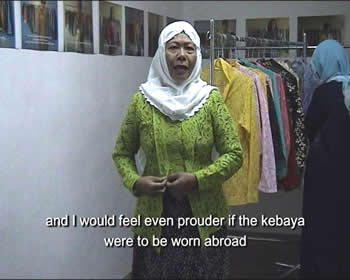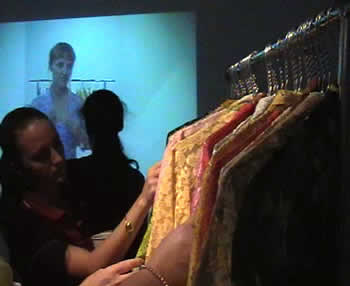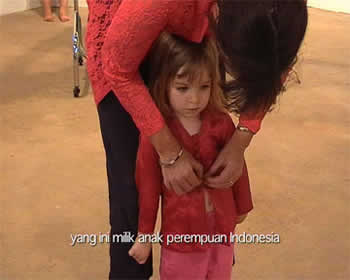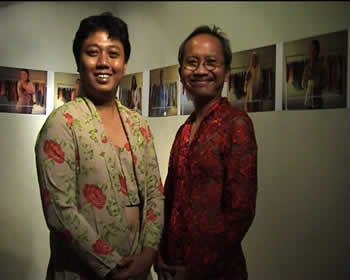Home | Vol 18 Table of Contents | Previous Issues | Contact Us: 07 55278753 / 0405463663 | Email: judybyronbay@yahoo.com
Reading the Kebaya
An ongoing video installation performance project by Victoria Cattoni
Written by Ishta Wilson with thanks to Victoria Cattoni
The Exhibition - "Through The Kebaya" Video Installation Performance was held at Charles Darwin University Gallery July 7-9 2004
Victoria Cattoni is an Australian contemporary artist who has spent many years living and working in Indonesia. Most recently she has been working between Darwin and Indonesia , completing an MVA at the Northern Territory University. Victoria’s research and creative investigation has been focused on the kebaya - the traditional blouse for women in Indonesia. Specifically, she has been concerned with reading constructions of femininity through the kebaya.
Victoria Catonni describes her project:
‘Reading the Kebaya is part of an ongoing Video Performance based research project, which utilizes the kebaya…as a tool for an exploration into constructions of cultural identity, in particular in relation to aspects of the ‘feminine’ within Indonesia…Video Performance is used as the structure for a social space in which a public interaction takes place. A diverse group of individuals of mixed – cultural, socio-economical, religious and aged – backgrounds interact with the kebaya: they ‘perform’, moving through a process of self recognition, reflection, criticism and re-construction, revealing the multiple meanings and nuances that lie beneath the kebaya. The kebaya begins to operate as a ‘doorway’ for an examination of femininity in relation to cultural, personal and collective identity.’ (Personal writing by Victoria Cattoni, 2003).
 |
 |
This trans-cultural project has been developed as a generative project, which
to date has been presented in several video installation performance exhibitions.
In 2002 this project was exhibited at NTU Gallery in Darwin, Australia, entitled
Tamasya Kebaya. In 2003, entitled Membaca Kebaya: reading the kebaya, it was
presented at Galeri Lontar in Jakarta, Indonesia.
An extract from the catalougoue for Temasya Kebaya describes the general structure of these exhibitions:
Enter a space somewhat resembling a fashion boutique: rows of kebaya in an assortment of colours and sizes, for children through to adult women. In one corner hangs a wide mirror. Close-by a tv monitor screens video documentation of Balinese models wearing the kebaya in a variety of poses and situations. With Victoria’s guidance, visitors go through the motions of fitting themselves into the kebaya while facing this apparatus. A camera monitors their dressing movements simultaneously projecting them onto a wide screen. (Krisna Murti & James Bennett, Tamasya Kebaya, ex.cat., Charles Darwin University Galllery, Darwin: Australia, 2002).
 |
The interactive nature of these exhibitions make them a unique experience, where the public and Victoria can gain information by seeing the variety of reactions to the kebaya from a broad range of people. Including the ‘performance’ by the exhibition audience, videos of individuals interacting with the kebaya were created through a series of workshops, which also act as an integral aspect of this ongoing project.
Curator Asikin Hasan from Galeri Lontar observes how reactions to the kebaya differ, ‘some feel wearing the kebaya provides a unique pleasure; others feel it an inappropriate costume nowadays; still others comment that it restricts movement and makes them feel awkward; yet the close-fitting kebaya, open at the neck, convinces others that wearing it is sexually enticing’ (Asikin Hassan, ‘The Kebaya in Parts’, from Membaca Kebaya: reading the kebaya, ex.cat., Galeri Lontar, Jakarta: Indonesia, 2003). The varied reactions from women both inside and outside of Indonesia is precisely what Victoria is generating with these exhibitions. She sees herself as a gatherer and commentator on the realities of the kebaya, ‘the result being that constructions of the feminine within a number of different social and cultural milieus…can be considered alongside one another.’ (Victoria Cattoni, from Membaca Kebaya: reading the kebaya, ex.cat., Galeri Lontar, Jakarta: Indonesia, 2003).
 |
 |
Victoria’s focus in this project has been to create a space were by seeing, hearing and interacting with the languages and responses of many individual women the work creates a reflective space, challenging our presumptions concerning both gendered and cultural identity.
Continuing with this project Victoria is having an exhibition in Darwin in July 2004 and in August there will be two exhibitions held in Yogyakarta, Indonesia. The first of these exhibitions will be held at gallery Kedai Kebun, with a satellite, video work from a recent workshop screening at gallery RuangMes56. Depending on interest and funding Victoria also has ideas to take Reading the Kebaya, as an intercultural project, to some Australian regional galleries. In conjunction with these exhibitions Victoria would run workshops in these places with groups of youth, to educate and broaden peoples understanding of Indonesia and increase the positive relationships between our two countries.
 |